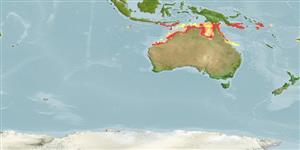Environment: milieu / climate zone / depth range / distribution range
Ecology
Marine; benthopelagic, usually 8 - 10 m (Ref. 27621). Tropical; 9°S - 21°S
Western Pacific: northern Australia. Almost certainly present in southern Papua New Guinea.
Size / Weight / Age
Maturity: Lm ? range ? - ? cm
Max length : 32.0 cm TL male/unsexed; (Ref. 3132); common length : 20.0 cm TL male/unsexed; (Ref. 27621)
Dorsal spines (total): 8; Dorsal soft rays (total): 14; Anal spines: 3; Anal soft rays: 12. Three dark vertical bands from nape, the first through eye, the second along the edge of the preopercle and the third down to the base of the pectoral fins; Dorsal fin with 8 spines increasing in length from a small anterior spine to a long posterior one; soft dorsal rays 14, much higher than spinous part and with the anterior ray produced into a short filament, the third ray prolonged into a long simple filament which extends past the caudal fin and the fourth and fifth rays also extended to beyond the hypural joint; anal fin with 3 slender spines and 12 soft rays, the second ray prolonged beyond the caudal fin and the third ray almost as long in small specimens.
Inhabit trawling grounds. Found more frequently in moderate depths on the continental shelf particularly close to submerged reefs or rough bottom (Ref. 27621). Feed mainly on crustaceans (Ref. 27621). Some cuttlefish are also taken (Ref. 27621).
Life cycle and mating behavior
Maturities | Reproduction | Spawnings | Egg(s) | Fecundities | Larvae
McKay, R.J., 1997. FAO Species Catalogue. Vol. 17. Pearl perches of the world (family Glaucosomatidae). An annotated and illustrated catalogue of the pearl peches known to date. FAO Fish. Synop. 125(17):26p. Rome: FAO. (Ref. 27621)
IUCN Red List Status (Ref. 130435)
Threat to humans
Harmless
Human uses
Fisheries: minor commercial
Tools
Special reports
Download XML
Internet sources
Estimates based on models
Preferred temperature (Ref.
123201): 26.7 - 28.8, mean 28 °C (based on 505 cells).
Phylogenetic diversity index (Ref.
82804): PD
50 = 0.6250 [Uniqueness, from 0.5 = low to 2.0 = high].
Bayesian length-weight: a=0.01995 (0.00906 - 0.04395), b=3.01 (2.83 - 3.19), in cm total length, based on all LWR estimates for this body shape (Ref.
93245).
Trophic level (Ref.
69278): 4.1 ±0.48 se; based on food items.
Resilience (Ref.
120179): Medium, minimum population doubling time 1.4 - 4.4 years (Preliminary K or Fecundity.).
Fishing Vulnerability (Ref.
59153): Low vulnerability (22 of 100).
Nutrients (Ref.
124155): Calcium = 89.3 [49.7, 187.5] mg/100g; Iron = 0.754 [0.431, 1.340] mg/100g; Protein = 17.5 [16.4, 18.6] %; Omega3 = 0.207 [0.108, 0.387] g/100g; Selenium = 63.9 [31.1, 136.8] μg/100g; VitaminA = 27.9 [8.0, 98.2] μg/100g; Zinc = 0.988 [0.668, 1.518] mg/100g (wet weight);
